The Crucial MX300 750GB SSD Review: Micron's 3D NAND Arrives
by Billy Tallis on June 14, 2016 9:00 AM ESTMixed Random Read/Write Performance
The mixed random I/O benchmark starts with a pure read test and gradually increases the proportion of writes, finishing with pure writes. The queue depth is 3 for the entire test and each subtest lasts for 3 minutes, for a total test duration of 18 minutes. As with the pure random write test, this test is restricted to a 16GB span of the drive, which is empty save for the 16GB test file.
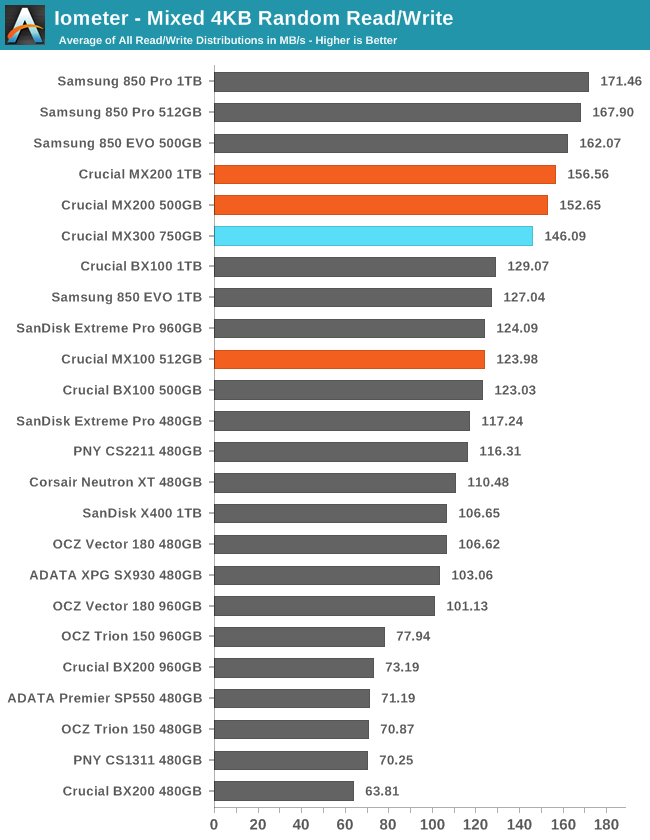
Despite poor random read speeds, the MX300 is only slightly slower than the MX200 on mixed random workloads, and is faster than most MLC drives.
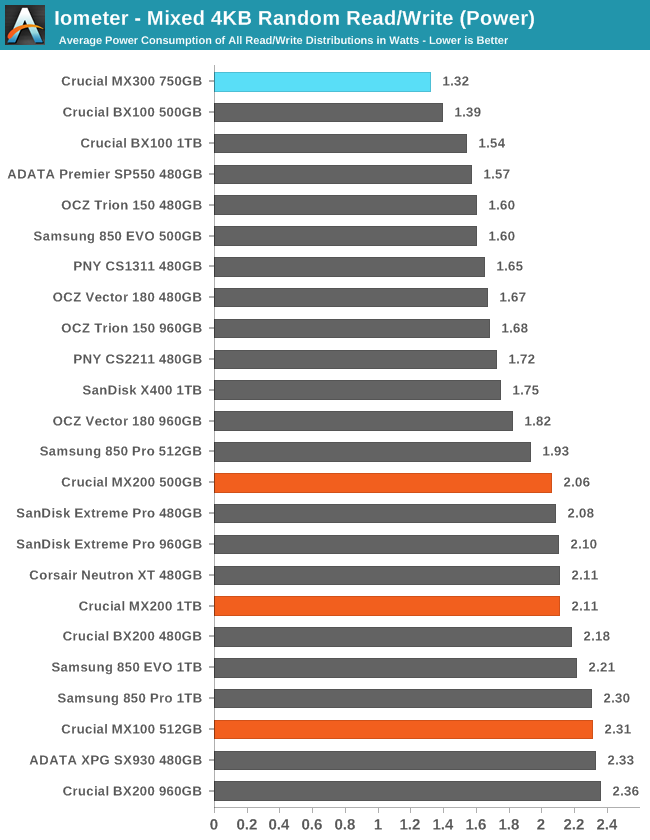
Once more setting a power usage record, the MX300 is more efficient than even the BX100.
 |
|||||||||
The MX300 manages to never decrease in performance when the proportion or writes increases, showing that its SLC write caching is working very effectively. Power consumption doesn't begin to increase until the test is almost completely writes.
Mixed Sequential Read/Write Performance
The mixed sequential access test covers the entire span of the drive and uses a queue depth of one. It starts with a pure read test and gradually increases the proportion of writes, finishing with pure writes. Each subtest lasts for 3 minutes, for a total test duration of 18 minutes. The drive is filled before the test starts.
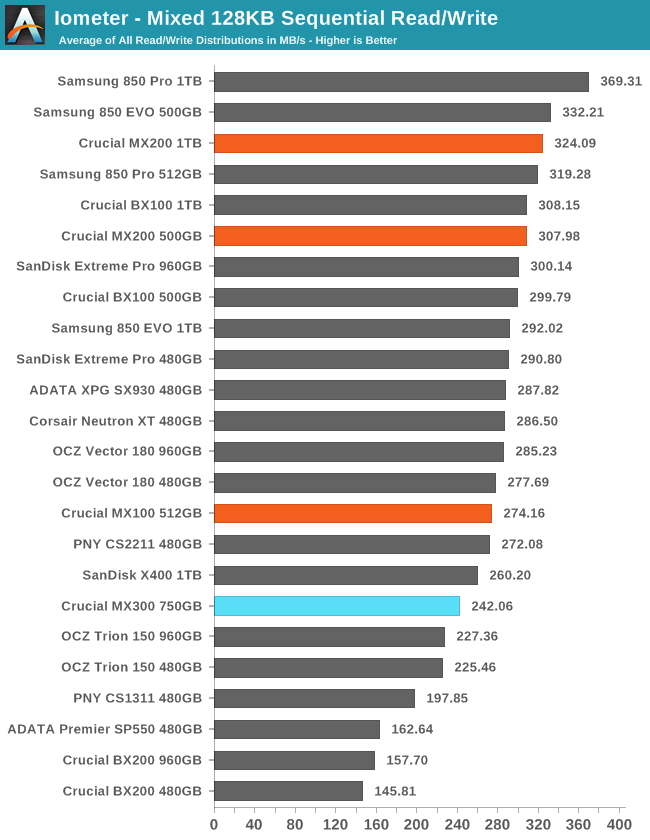
Since SATA drives all perform about the same on sequential reads, rankings on this test are determined mainly by sequential write performance and whether the controller can process the mixed workload effectively. The MX300 is slower than the SanDisk X400 but faster than the other planar TLC drives.
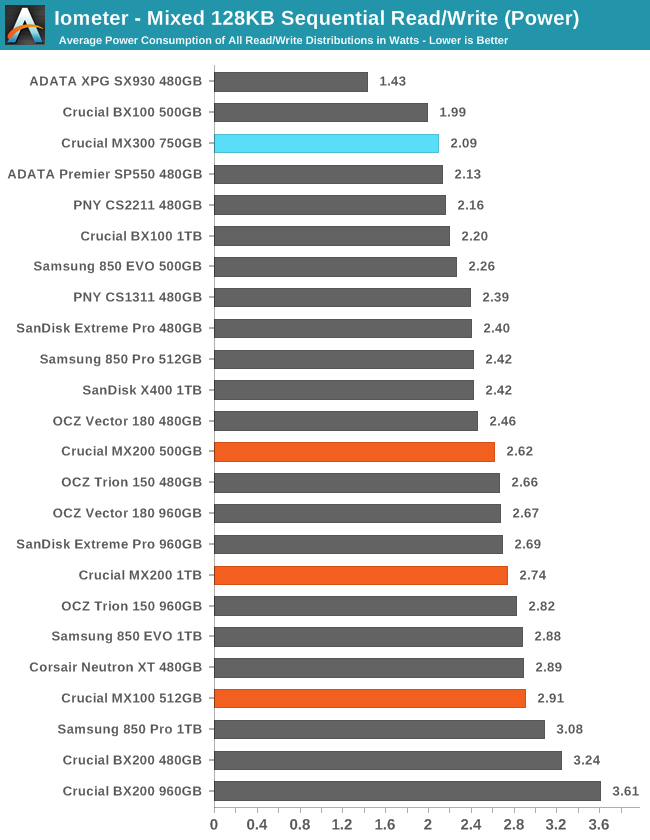
With another third place ranking for power usage, the MX300 beats all the planar TLC drives on efficiency but is unremarkable by MLC standards.
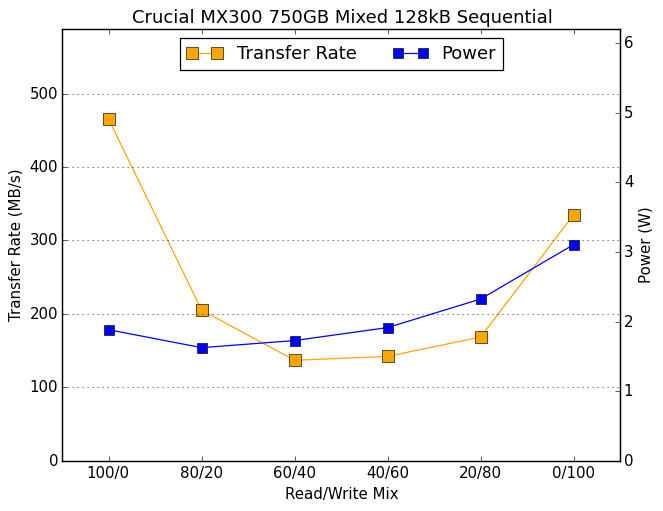 |
|||||||||
The MX300 bottoms out around 126MB/s which would be respectable for a planar TLC drive, but the MX200 never drops below 200MB/s.










85 Comments
View All Comments
Gondalf - Wednesday, June 15, 2016 - link
Good point. The real story the have not even read the article, or maybe there is a lot of marketing guys at work here.After all Samsung has shipped for two years 3D SSD drivers in nearly money loss cause the low yields of their manufacturing process on a 3D structure.
icrf - Tuesday, June 14, 2016 - link
What is the expected performance of the 3D MLC NVMe SSD, or is that too many variables different to tell from here? I'm curious if the charge trap/floating gate decision affected performance.jabber - Tuesday, June 14, 2016 - link
I'm taking it that Crucial have given up on SSD R&D? After all each Crucial SSD post BX100 (what a great SSD) just gets slower than the previous.JoeyJoJo123 - Tuesday, June 14, 2016 - link
If Crucial has "given up" then what does that speak for Toshiba and other manufacturers that STILL haven't done 3D stacked MLC NAND?Samsung led the innovation 2 years ago and now their first competitor just showed up.
vladx - Tuesday, June 14, 2016 - link
Sandisk X400 seems to be the king of budget SSDs, paying 80USD more for 850 EVO is definitely not worth it imo.Meteor2 - Tuesday, June 14, 2016 - link
Can't dispute that.Lolimaster - Saturday, June 18, 2016 - link
They're not.Unless you move tons of data per day with more than 1 pci-e nvme drive there's no difference between sata and pcie ssd's. PCie ssd uses more power and produces more heat.
Communism - Tuesday, June 14, 2016 - link
With the advent of PCIE 3.0 X4 NAND drives a while ago, the whole SATAIII segment of SSDs are essentially obsolete. The lack of significant competition in the PCIE3.0 X4 NAND drives bringing down prices quickly is disconcerting.The only COGS difference between PCIE3.0 X4 NAND drives and SATAIII drives is the controller, which doesn't actually cost much at all.
Buying into SATAIII SSDs at this point in time simply is a bad idea comparatively.
TheinsanegamerN - Tuesday, June 14, 2016 - link
Sara is hardly obsolete. Pcie m2 drives still only hit 512gb vs the 2tb sata drives, still run hotter, and don't offer much but a faster boot time. Day to day performance between sata and pice is nil unless you are moving hundreds of gigs of data per day onto/off of the drive.Until m.2 is cheaper, cooler, and the same capacity as sata, sata isn't going anywhere.
vladx - Tuesday, June 14, 2016 - link
Actually, NVMe drives boot slower because of additional drivers needed to be loaded.